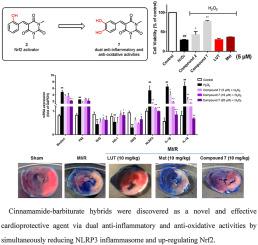European Journal of Medicinal Chemistry ( IF 6.0 ) Pub Date : 2022-10-15 , DOI: 10.1016/j.ejmech.2022.114848 Yang-Yang Shi 1 , Bo Wei 1 , Jing Zhou 2 , Zhi-Li Yin 1 , Fei Zhao 1 , Ya-Jie Peng 1 , Qing-Wen Yu 1 , Xin-Lu Wang 1 , Ya-Jing Chen 1

|
Myocardial ischemia/reperfusion (MI/R) injury is still the huge unmet medical need without effective therapy in clinic. It is critical to develop pharmacological intervention to scavenge ROS and inhibit NLRP3 activation to have a double benefit against MI/R injury. Cinnamamide derivatives have been demonstrated to possess anti-oxidative and anti-inflammatory activities. Previously, we have reported that a cinnamamide derivative 2 exerts excellent cardioprotective effect via mediation of intracellular oxidative stress via Nrf2 up-regulation against MI/R. In the present study, seventeen compounds have been optimized using cinnamamide-barbiturate hybrid 2 as the lead compound and their cardioprotective activities against MI/R were further determined in vitro and in vivo. Among them, compound 7 showed the most potent cardioprotective effect and low cytotoxicity. While cardiomyocytes were invased by hydrogen peroxide, compound 7 exhibited more excellent cardioprotective effect than that of luteolin and metoprolol, the positive control employed in the present study, as demonstrated by dramatically elevated cell survival rate and decreased LDH leakage rate. Moreover, compound 7 markedly inhibited cardiac expressions of inflammasome activation and pro-inflammatory cytokines release (i.e. NLRP3, IL-1β, IL-18), simultaneouly increasing endogenous antioxidative proteins (i.e. Nrf2, HO-1 and SOD) in vitro. In the rat MI/R model, compound 7 pretreatment profoundly reduced cardiac infarct size in MI/R rats and reversed abnormal changes in myocardial enzymes and lipid peroxidation levels in heart tissues. Mechanistically, compound 7 revealed significant cardioprotective effects by inhibiting NLRP3 and its downstream inflammatory chemokine IL-1β, as well as up-regulating Nrf2 in vivo. Furthermore, at the active site of the co-crystal of NLRP3 and Nrf2, compound 7 exhibited higher binding force in the molecular docking study, which was consistent with the in vitro results. Therefore, compound 7 is expected to be a potential cardioprotective agent possessing dual anti-inflammatory and anti-oxidative activities. Our work provides an important therapeutic strategy for the treatment of ischemic-reperfused heart disease.
中文翻译:

发现 5-(3,4-二羟基亚苄基)-1,3-二甲基嘧啶- 2,4,6(1H,3H,5H)-三酮作为具有双重抗炎和抗氧化活性的新型有效心脏保护剂
心肌缺血/再灌注(MI/R)损伤仍然是临床上没有有效治疗的巨大未满足医疗需求。开发药物干预以清除 ROS 和抑制 NLRP3 激活对于对抗 MI/R 损伤具有双重益处至关重要。肉桂酰胺衍生物已被证明具有抗氧化和抗炎活性。以前,我们曾报道肉桂酰胺衍生物2通过 Nrf2 上调对抗 MI/R 介导细胞内氧化应激发挥出色的心脏保护作用。在本研究中,以肉桂酰胺-巴比妥酸盐杂合物2作为先导化合物优化了 17 种化合物,并在体外进一步测定了它们对 MI/R 的心脏保护活性和体内o。其中,化合物7表现出最强的心脏保护作用和低细胞毒性。当过氧化氢侵入心肌细胞时,化合物7表现出比本研究中使用的阳性对照木犀草素和美托洛尔更优异的心脏保护作用,如显着提高的细胞存活率和降低的 LDH 渗漏率所证明的那样。此外,化合物7在体外显着抑制炎症小体激活和促炎细胞因子释放(即 NLRP3、IL-1β、IL-18)的心脏表达,同时增加内源性抗氧化蛋白(即 Nrf2、HO-1 和 SOD)。在大鼠 MI/R 模型中,化合物7预处理显着减少了 MI/R 大鼠的心肌梗死面积,并逆转了心肌酶和心脏组织中脂质过氧化水平的异常变化。从机制上讲,化合物7通过抑制 NLRP3 及其下游炎症趋化因子 IL-1β 以及体内上调 Nrf2 显示出显着的心脏保护作用。此外,在NLRP3和Nrf2共晶的活性位点,化合物7在分子对接研究中表现出更高的结合力,这与体外结果一致。因此,化合物7有望成为具有双重抗炎和抗氧化活性的潜在心脏保护剂。我们的工作为治疗缺血再灌注心脏病提供了重要的治疗策略。













































 京公网安备 11010802027423号
京公网安备 11010802027423号